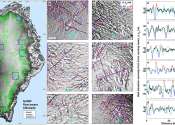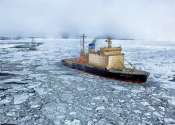An ice sheet is a mass of glacier ice that covers surrounding terrain and is greater than 50,000 km² (20,000 mile²). The only current ice sheets are in Antarctica and Greenland; during the last glacial period at Last Glacial Maximum (LGM) the Laurentide ice sheet covered much of Canada and North America, the Weichselian ice sheet covered northern Europe and the Patagonian Ice Sheet covered southern South America.
Ice sheets are bigger than ice shelves or glaciers. Masses of ice covering less than 50,000 km2 are termed an ice cap. An ice cap will typically feed a series of glaciers around its periphery.
Although the surface is cold, the base of an ice sheet is generally warmer due to geothermal heat. In places, melting occurs and the melt-water lubricates the ice sheet so that it flows more rapidly. This process produces fast-flowing channels in the ice sheet — these are ice streams.
The present-day polar ice sheets are relatively young in geological terms. The Antarctic Ice Sheet first formed as a small ice cap (maybe several) in the early Oligocene, but retreating and advancing many times until the Pliocene, when it came to occupy almost all of Antarctica. The Greenland ice sheet did not develop at all until the late Pliocene, but apparently developed very rapidly with the first continental glaciation. This had the unusual effect of allowing fossils of plants that once grew on present-day Greenland to be much better preserved than with the slowly forming Antarctic ice sheet.









